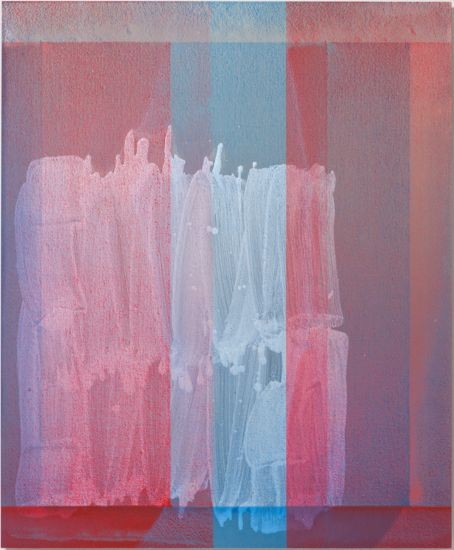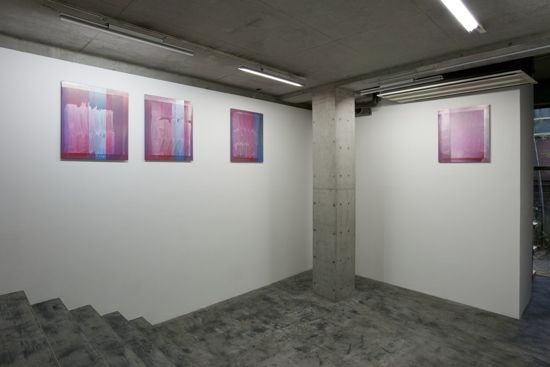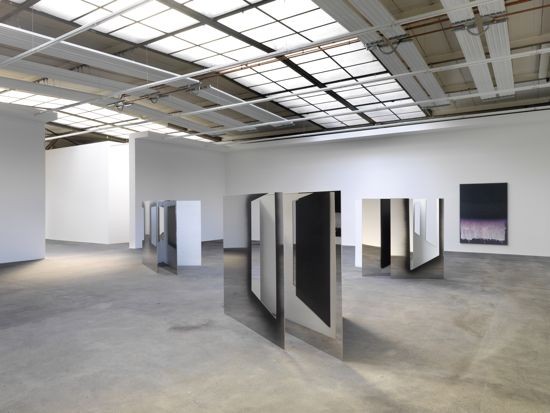PROCESS PRESENT TENSE
By Andrew Maerkle

Untitled (2010), acrylic, silkscreen on aluminium, 86.3 x 58.4 cm. Photo Kei Okano, courtesy
Nathan Hylden and Misako & Rosen.
I. Mirror Takes Time
ART iT: I’d like to begin by discussing your early works and your use of collage, which seems to anticipate your current interest in stencils and seriality. At the time, did you approach collage as a specific field of reference or was it simply an organic development for you?
NH: For me, collage has been a way to incorporate image-based material alongside the painting in order to find some equivalence between the two. The first collages did not focus on any specific material, but gradually all the choices of the newspaper images came to focus on images of either things being broken or things being built, so in a sense as a parallel to the creative process as simultaneous destruction and construction.
I saw collage as both physically material in the sense that it’s present as a thing, but also temporal in the sense of going through the newspaper as a daily practice, and this is parallel to the way that my paintings develop through repetitions and the indexing of one to the next so that they all connect through a shared process. So in addition to visual parallels and formal similarities, temporality is a theme that extends through the collages to the paintings.
ART iT: Then in your paintings is your use of layering and different textures emerging out of this collage practice or is it a specifically painterly approach?
NH: I guess you could draw the parallel. I don’t know if I’d consider it as all emerging from collage, but because I work with stencils, in each painting there are always multiple parts fitting together, placed side-by-side or layered on top of each other. The paintings are visually abstract but they also have an image-based component in the sense that they always contain the negative of a stencil. In each painting there is always an indexical relationship to some other form: a kind of negative image from some other shape.
I started making works on paper where I was cutting shapes through the paper in stacks and then shuffling the papers and spray-painting on them so that each work was a work in its own right and also a stencil for producing another series. Each work was both an end and a means to another.
I also made sculptures that developed out of this relationship between painting and the stencil. I started with flat sheets of metal that were then cut in places and used as stencils for painting each other. For my solo show in 2007 at Richard Telles Fine Art in Los Angeles I made two polished aluminum sculptures, with more or less arbitrary cut-out forms, and then recently I made three steel sculptures with the shapes based on photographs of canvases in my studio. The sculptures were then exhibited with the paintings. The sculptures bear an impression of paintings in the studio as they were photographed in a specific situation that is different from how you encounter both paintings and sculpture in the exhibition. In this way, between the sculptures and the paintings, there are three or four levels of repetition and mirror doubling, so the idea of the indexical relationship to the stencil has grown into a significant part of the work itself. The relation of process and presence becomes overtly convoluted.


Top: Installation view at Misako & Rosen, Tokyo, 2010. Photo Kei Okano, courtesy Misako & Rosen, Tokyo. Bottom: Installation view of the exhibition “Getting There, In Various Order,” Johann König, Berlin, 2010. Courtesy Johann König, Berlin, and Misako & Rosen, Tokyo.
ART iT: How did you develop this interest in playing with signs and indexes and referents?
NH: I was interested in exploring how the referent is a contradiction of the presence of the object, because the indexical connects it to something outside of itself. On the one hand you have this object that, through the tradition of abstract painting, is a singular object that presents itself and exists on its own, but then it is also connected to other works through the process by which it was made. Each work holds within it the sign of the other works in the series, or the sign of the process by which they were made. Of particular interest is the contradiction of the work’s presence or, thinking in temporal terms, the mobilization of that presence by its indexical link to other works, so that whatever is specifically in the painting also has a sense of time.
The question of the presence of painting is something I’ve always been interested in, as well as the idea of deferred presence, where something is present but there’s also something outside of it withstanding, something forthcoming that makes a thing more than just a typical object. I was already thinking about this in school and then it developed into this idea of using the canvases themselves to make new paintings, and that helped push it along to thinking about how you could see an object but also know that that’s not the entirety, obviating this condition of painting. With each of these paintings, you might be able to see minor disruptions in the stencil, because for an entire year when I painted the canvases, I was putting sheets of paper underneath the stencils, causing omissions in the pattern. Sometimes I repainted the omitted area, other times I left the pattern disrupted. There were four sheets of paper for every painting, and I saved them all, so the idea is that there’s a missing piece of each canvas that functions as an index to my entire production for one year.
Nathan Hylden: Process Present Tense
